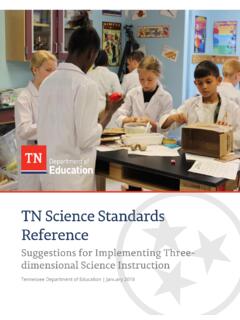Transcription of Module Eleven - Virginia Department of Education
1 Module Eleven Behind-the-Wheel and In-Car Observation Virginia Department of Education in cooperation with the Virginia Department of Motor Vehicles Curriculum Scope and sequence Modules for Driver Education in Virginia table of Contents Standards of Learning Addressed in This Module ..1 Introduction ..3 Behind-the-Wheel and In-Car Observation Recommendations ..4 Behind-the-Wheel Student Record Form .. 6 In-Car Route Plan ..7 In-Car Skills ..8 Student In-Car Performance Record ..17 Lessons Lesson 1 .. 18 Lesson 2 .. 20 Lesson 3 .. 22 Lesson 4 .. 24 Lesson 5 .. 26 Lesson 6 .. 28 Lesson 7 .. 30 Lesson 8 .. 33 Lesson 9 .. 35 Lesson 10 ..36 Lesson 11 ..38 Road Skills Evaluation Support Information .. 39 Mid-Point Evaluation .. 40 Road Skills Evaluation .. 41 Standards of Learning Addressed In This Module The student will demonstrate an understanding of basic vehicle operating procedures. Key concepts/skills include a) pre-driving procedures; b) starting procedures (automatic and manual transmissions); c) vehicle information, warning, and control devices; d) vehicle securing procedures.
2 The student will recognize the effects of momentum, gravity, and inertia on vehicle control and balance, and the relationship between kinetic energy and force of impact. Key concepts/skills include a) seating and hand position; b) steering, braking, and acceleration; c) compensating for shifts in vehicle load (from side to side, front to rear, and rear to front) that affect vehicle performance; d) types of collisions head-on, near-frontal, broadside, rear-end, rollover, sideswipe. The student will demonstrate the ability to manage visibility, time, and space to avoid conflicts and reduce driving risks. Key concepts/skills include a) synthesizing information visually from the driving environment, using a space-management process; b) applying following-interval concepts; c) selecting gap and judging distance; d) estimating passing-time and space needs. The student will demonstrate appropriate adjustments when approaching controlled and uncontrolled intersections, curves, railroad crossings, and hills with line-of-sight or path-of-travel limitations.
3 Key concepts/skills include a) roadway signs, signals, and markings; b) right-of-way rules; c) slope/grade of terrain; d) vehicle position. The student will identify the characteristics of an expressway and apply risk-reducing expressway driving strategies. Key concepts/skills include a) entering, merging, integrating into, and exiting from traffic flow; b) managing interchanges; c) selecting vehicle position and changing lanes. The student will demonstrate the ability to communicate presence and intentions with other highway transportation users. Key concepts/skills include a) vehicle position and driver action; b) vehicle communication devices. The student will identify and analyze the legal, health, and economic consequences associated with alcohol and other drug use and driving. Key concepts/skills include a) positive and negative peer pressure; b) refusal skills; c) Implied Consent, Zero Tolerance, and Use and Lose laws; d) Administrative License Revocation, loss of license, ignition interlock, and other licensing restrictions; e) court costs, insurance requirements, Virginia Alcohol Safety Action Program referral, and other costs.
4 Module Eleven August, 2001 Page 1 ..continued The student will identify changes in the environment that affect visibility and traction and demonstrate an understanding of appropriate driver reaction to these risks. Key concepts/skills include a) driving at night; b) smoke- and weather-related conditions; c) road conditions and construction; d) vehicle stability and traction control systems. The student will demonstrate an understanding of the proper use of vehicle occupant protection features and analyze how they reduce injury severity and increase collision survival. Key concepts/skills include a) active restraint systems; b) passive restraint systems; c) child restraint systems; d) highway safety design. The student will identify and evaluate emergency response strategies to reduce the severity of or avoid a collision in high-risk driving situations.
5 Key concepts/skills include a) evasive maneuvers, using brake and steering combinations; b) off-road recovery; c) front and rear traction control. The student will identify and describe the performance characteristics of other road users and apply problem-solving skills to minimize risks when sharing the roadway with a) pedestrians and animals; b) pedalcycles and motorcycles; c) tractor-trailers, trucks, and construction vehicles; d) sport utility vehicles, recreation vehicles, and trailers; e) emergency vehicles; f) funeral processions; g) passenger and school buses; h) farm machinery and horse drawn vehicles. The student will compare vehicle-braking systems and explain proper braking techniques for various weather and roadway conditions. Key concepts/skills include a) small and large vehicle conventional brake systems; b) two- and four-wheel anti-lock brake systems (ABS). The student will analyze how preventive maintenance reduces the possibility of vehicle failures and recognize the warning signs that indicate the need for maintenance, repair, or replacement.
6 Key concepts/skills include a) vehicle warning devices; b) lights and signals; c) steering and suspension systems; d) tires and braking systems; e) fuel and ignition electronics. Module Eleven August, 2001 Page 2 Module Eleven Introduction Module 11 contains sample in-car lessons that compliment classroom instruction. Suggested in-car lessons have been developed for a standard seven period driving, seven period observing behind-the-wheel program. Sample record sheets and evaluation tools are included. Lesson 1 This lesson introduces the checks made by the driver when approaching the vehicle, adjustments made prior to starting the vehicle, starting procedures, and how to move the vehicle away from and to the curb. The recommended instructional time is 25 minutes driving and 25 minutes observing. ( Module Two) Lesson 2 This vehicle control and basic procedures lesson reinforces procedures included in Lesson 1 and introduces targeting, sightlines, path of travel and reference points.
7 The student performs basic vehicle control maneuvers in a controlled environment. The recommended instructional time is 25 minutes driving and 25 minutes observing. ( Module Two) Lesson 3 This lesson introduces basic maneuvers at low speed and in a low risk environment. The student is introduced to intersections, right-of-way concepts, turns, and parking. The recommended instructional time is 25 minutes driving and 25 minutes observing. ( Module Three) Lesson 4 This basic maneuvers in low risk environment lesson reinforces tasks learned in previous lessons and introduces 2-point turnabouts, 3-point turnabouts, U turns and parking procedures. The recommended instructional time is 25 minutes driving and 25 minutes observing. (Modules One, Two, and Three) Lesson 5 This basic maneuvers in moderate risk environment lesson reinforces driving tasks learned in prior lessons and introduces the student to moderate risk driving environments.
8 The recommended instructional time is 25 minutes driving and 25 minutes observing. (Modules One, Three, and Four) Lesson 6 This lesson utilizes a space management system to identify risk using commentary driving. Driving tasks taught in prior lessons are reinforced and space management concepts are emphasized. The recommended instructional time is 25 minutes driving and 25 minutes observing. (Modules One, Two, Three, Four, and Five) Lesson 7 Continued emphasis is placed on using space management techniques while introducing the student to more demanding driving experiences. The recommended instructional time is 25 minutes driving and 25 minutes observing. (Modules One, Two, Three, Four, and Five) Lesson 8 This basic maneuvers in complex traffic situations lesson reinforces driving tasks learned in prior lessons and places the student in more complex traffic situations. A minimum of 50 minutes driving and 50 minutes observation is recommended.
9 The driver/observer should switch positions every 25 minutes. (Modules One, Two, Three, and Eight) Lesson 9 Brake failure, engine failure, accelerator failure, traction loss and collision avoidance techniques are simulated in this lesson using a driving range environment or parking lot. The recommended instructional time is 25 minutes driving and 25 minutes observing. (Modules Two and Nine) Lesson 10 The backing maneuvers exercise demonstrates accuracy in both reverse and forward driving tasks in the range / parking lot environment. The recommended instructional time is 25 minutes driving and 25 minutes observing. (Modules Two and Three) Lesson 11 The final road skills assessment is conducted on a pre-determined driving route utilizing all driving tasks with no assistance from the instructor or observer. The recommended instructional time is 50 minutes driving and 50 minutes observing. ( Module Nine) Module Eleven August, 2001 Page 3 Behind-the-Wheel and In-Car Observation Recommendations Teachers should develop written lesson plans for behind-the-wheel instruction and in-car observation that reflect local driving environments.
10 It is also important to have procedures, techniques, and route selections clearly written to avoid tort liability problems. Program administrators should have copies of the routes and lesson plans on file. Teachers should also maintain a daily driving record for each student which contains instructional time, mileage and skill assessments. The following information will assist in developing route plans for behind-the-wheel instruction, in-car observation, and guiding parental practice sessions. Select a drive route appropriate to the individual lesson objectives and student-driver s ability. Be prepared with an alternate route in case of detours or other traffic problems. At the beginning of each session, make sure the student driver and observer understand the objectives of the lesson, and do a quick review of the preceding session. Check to make sure the students have their learner s permits. Be calm and patient, but be alert at all times.
















